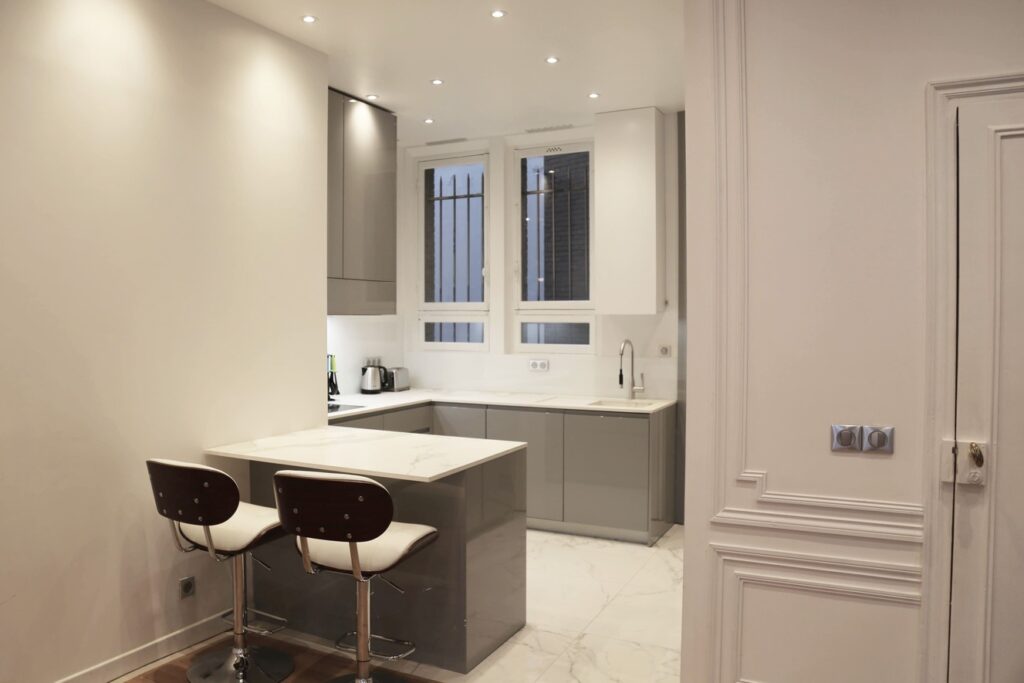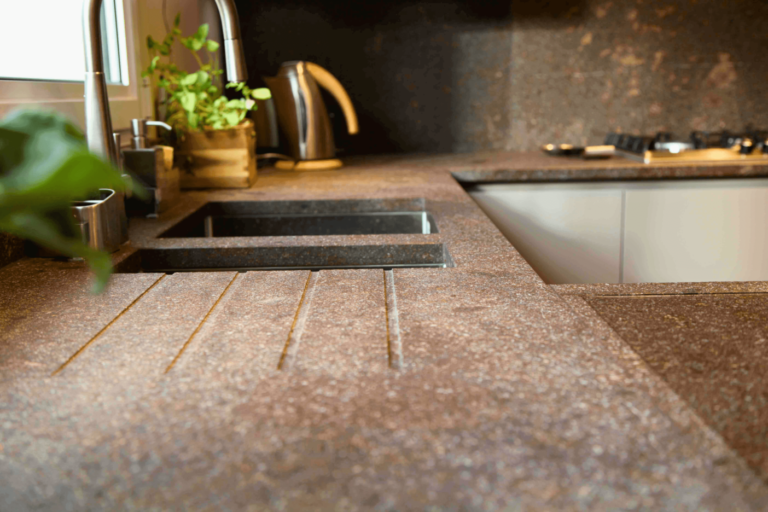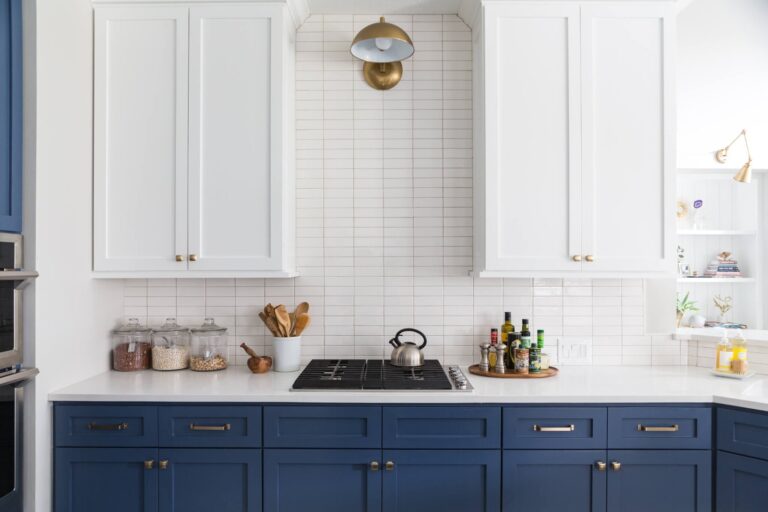The Art of Kitchen Lighting! Learn How Can Lights Reflect The Beauty of Your Kitchen
As the heart of the home, kitchens nowadays are a multi-functional space that serve not only for cooking, dining, and preparing some delicious meals, but also for socializing and making conversations with our lovely family members. Proper lighting not only enhances the functionality of your kitchen but also adds to its aesthetic appeal. In this blog, we’ll delve into the key factors of choosing kitchen lighting, ensuring your culinary haven shines brightly.
At the beginning, if you want to light your kitchen, the very first question that might come to your mind is: what type of lights should I select?. To solve this speculation, we are going to present to you three main types of lighting that you should keep in mind before choosing lights for your Kitchen.
The main three Lighting Types are:
1- Ambient Lighting or what is called general lighting. This type provides light to your kitchen overall. You can get this illumination simply by ceiling-mounted fixtures like recessed lights, neon on the walls or by just track lighting that is fixed on the top-back of the kitchen cabinets.
2-Task lighting is a focused form of lights designed to illuminate specific areas in the kitchen such as the counter-top, stove, or sink. People might choose this type of lighting as it functions to make doing some tasks easier like chopping, food preparation, or simply cooking. Under cabinets lighting is the best task lighting because there’s nothing to create shadows, and the light can be very bright and focused without casting harsh light into the main kitchen area. These fixtures are sleek and essentially invisible once they are installed
3-Accent Lighting or highlight lighting can be used to show the aesthetic architectural features and decorative elements in the kitchen. It can be used also to draw attention and raise interest for a specific design in the kitchen. Below are four common purposes of using this type of light:
- Highlighting Artwork: as if the ceiling of your kitchen has artistic decoration and you want to make this obvious.
- Enhancing Architectural Features: if your kitchen contains designed beams, wall niches, or just windows then accent light is your best bet.
- Adding Depth and Dimension: This type of lighting functions well in small kitchens as it makes the kitchen feel more spacious and open.
- Creating a Warm and Inviting Atmosphere as it gives your kitchen the feeling of being cozy and comfortable.
Having defined the types of lighting and the reason behind choosing one type of them over another, we should move onto the next stage. In this phase, there are some of the key factors that play a vital role in kitchen lighting which can make them function better and more efficiently.
Below are four Kitchen lighting fundamentals that you need to consider:
1- Kitchen design and Layout
First and the most important factor to take into consideration is kitchen layout and design. Some might underestimate this element and immediately run for buying the lights they prefer. AR-diffusion advises you to study the design of your kitchen carefully. Is it an open-plan space or a compact kitchen?. Identifying areas where lighting is needed most, such as above the counter-top, island, sink, and dining area. In fact, kitchen lighting won’t function as they are supposed to be without considering the design because the layout of your kitchen will help you make the right decision of buying the right type of lighting and will give you a vision on how the kitchen will be illuminated.
2- Style of the kitchen
This factor plays a significant role in determining the type of lighting that complements the design aesthetic of a kitchen. Some of these kitchen styles are modern, classic, farmhouse, and industrial style. Whether your kitchen is one of these styles, there are plenty of lighting options that suit every taste. For instance, sleek pendant lights work well in contemporary kitchens, while rustic chandeliers add charm to farmhouse-inspired spaces.
3- Evaluate Light Fixtures
Our kitchens are places that are designed to face different conditions like heat, moisture, and even chemical cleaning materials. These conditions force us to take into consideration the size, materials and quality of the light fixtures for our kitchens. To make sure that your choice is right, you can opt for fixtures that are proportional to the size of your kitchen and complement its existing decor. Additionally, choose durable materials that can withstand the rigors of the kitchen environment, such as stainless steel, glass, or acrylic. With the wide range of brands and materials in the market, you might get lost choosing the best option, so you can simply refer to a kitchen remodeling expert and leave your concerns behind.
4- Energy Efficiency
In today’s Eco-conscious world, energy-efficient lighting options are gaining popularity. LED (Light Emitting Diode) lights are an excellent choice for kitchen lighting due to their longevity, energy efficiency, and versatility. While LED lights may have a higher upfront cost, they consume less energy and last significantly longer than traditional incandescent or fluorescent bulbs, saving you money in the long run.
Another crucial topic that a lot of people are missing is kitchen lighting safety. Kitchen is the most vital space in our home. According to statistics, the average person spends 2.5 hours a day in the kitchen. This means that kitchens play a considerable role in our lives than we might expect. In that perspective, safety in kitchens must be a top priority for all kitchen owners. One type of kitchen safety is proper installation of kitchen lighting. Any fault in the lighting installation process, might put our homes and family members at risk and jeopardize our kitchens to fire.
In this section, we will provide you with the top common kitchen lighting hazards:
- Exposed wiring can deal serious damage to your kitchen as they can easily be affected by different kitchen conditions like heat.
- Circuits that are being overloaded might deal real damage ,and thus result in your kitchen to catch fire.
- Inappropriate installation of lighting fixtures can make a flaw in light distribution and the wires might heat up resulting in fire incidents.
To avoid all the above, we recommend you follow the below tips for ensuring kitchen lighting safety:
- Always look for an electrician or kitchen lighting professional for proper fixtures and light installation.
- Make sure you are using high-quality bulbs and ensure they are at the correct wattage.
- Avoid overloading circuits by unplugging unnecessary appliances.
- Consider using LED lights as they consume less energy and produce less heat than traditional light.
- Install a motion sensor, if possible, as it automatically turns lights off once a person comes out of the kitchen. This will reduce the risk of fire by leaving lights on accidentally for a very long time.
By understanding your kitchen’s layout, considering different types of lighting, matching fixtures to your kitchen’s style, and prioritizing energy efficiency and lighting safety, you can illuminate your lovely kitchen both effectively and efficiently making it shine bright with the perfect lighting solution tailored to your needs and preferences.




